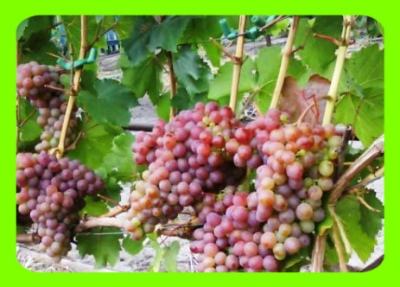
- Authors: VNIIViV them. ME AND. Potapenko, Russia
- Appointment: dining room
- Berry color: pink
- Taste: simple, with a slight nutmeg tone when fully ripe
- With bones: Yes
- Ripening period: early
- Ripening period, days: 110-120
- Frost resistance, ° C: -23
- Bunch weight, g: 400-800
- Yield: 3 kg / bush
It is not difficult to grow grapes on your site, it is enough to study the elementary rules of agricultural technology. From table varieties, Amirkhan will be a great addition to the table.
Breeding history
The variety appeared in our country thanks to the work of VNIIViV them. Ya. I. Potapenko, in the process of crossing Jagdon x Pearl Saba.
Description
Amirkhan bushes do not grow large in size. The shoots have a high ripeness of fruits. The foliage is oval in shape, there is a slight dissection, but the edges are solid.
Ripening period
Ripening period is early, on average it is 110-120 days.
Bunches
A distinctive feature of the described variety is the pea of the fruit. The clusters themselves are cylindrical-conical, dense. The mass of one can be from 400 to 800 grams.
Berries
The berries can be transported without any problems. Ripe grapes are pink in color, inside the seed. The skin is thin, almost invisible in the mouth. Juicy pulp is hidden under it.
The shape of the grapes is oval, the weight of one berry is 4 grams.
Taste
When fully ripe, a slight nutmeg flavor appears.
Yield
The yield of Amirkhan is estimated by experts as average. Up to 3 kg of berries are harvested from the bush.


Growing features
Landing
Planting is carried out in small pits. The soil does not fall asleep immediately - first the first layer is laid, then it is slightly compacted, watering is performed. Only then is the planting pit closed completely.
For planting, it is recommended to choose a well-lit, windless place with well-drained soil. Waterlogging threatens the appearance of many fungal diseases.

Pollination
Pollination is not required for the variety, since bisexual flowers form on the bush during vegetative growth.
Pruning
Pruning is an indispensable part of caring for a variety; a gardener cannot do without it.

Watering
With a lack of moisture in the soil, the berries become smaller, the vine grows worse, and as a result, the yield decreases. Therefore, if the soil is dry, the plants need to be watered.Do not use cold water, the roots are sensitive to it.
The average rate is 3-4 buckets of water per bush. After watering, the soil is loosened and mulched to retain moisture. Watering is stopped 2-3 weeks before the start of the harvest.


Top dressing
In temperate climates, especially if the summers are cool, grapes become difficult without proper care of the gardener. In the second half of summer, plants need help in forming the harvest and preparing for winter.
Along with the formation of fruits, wintering buds are laid on the vines - eyes for the next year's harvest. Then the growth of shoots slows down and the outflow of nutrients begins to the perennial parts of the bush and to the roots. It is very important to accumulate enough reserves so that they will be enough for the whole long winter and spring regrowth of shoots.
Simultaneously with watering, the plants are fed. Complex mineral fertilizers with microelements are preferred, organic fertilizers are suitable: mullein infusion, bird droppings and ash.
In general, 4 root dressings are carried out per season. The first time - in early spring, the second - during the period of active growth of shoots and leaves (before flowering), and the third - apply phosphorus-potassium fertilizers at the beginning of pouring berries. The fourth dressing is carried out after harvesting, it is necessary to accelerate the ripening and lignification of the shoots.
Frost resistance and the need for shelter
Frost resistance is -23 ° С. If the Amirkhan variety is grown in a temperate climate, then for the winter it should be removed from the trellis, laid in a groove and covered with spruce branches.

Diseases and pests
Experts estimate resistance to mildew at 3.5 points, to gray mold - by 4. At the same time, preventive treatment in early spring with sulfur-based fungicides and insecticides against pests is necessary.

If a grape is exposed to any disease or insect, this always affects its appearance.
Storage
The shelf life of the fruit after harvest is 30 to 60 days. Marketability is assessed as high.











































































